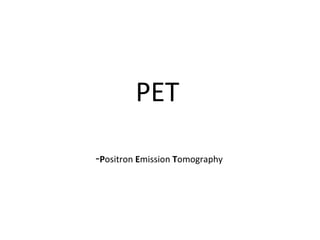
PET Scan Reveals Metabolic Activity in the Body
- 2. What Is PET? • Nuclear medicine scan, Functional imaging technique. • Quantifiable – amount of radiation depends on rate of metabolic activity • non-invasive, but does involves exposure to ionizing radiation, • Usage of radioactive isotopes (radiopharmacons) emitt β⁺ particles
- 3. How Does PET Work? • Administration of radiopharmacon • Decay of isotope internally, accumulation of radiopharmacon in diseased tissue. • Electron interaction annihilation emission of 2 gamma photons. • Scintillating detectors ( gamma camera). • Collection and storage of data reconstruction of 2D distribution map. • Most scans today are combined with CT.
- 6. Collection Of Data – Lines Of Conicidence Linear sampling – defining parallel coincidence sampling paths. Each detector can be operated in multiple coincidence with many detectors across from it.
- 7. Radioactive Isotopes Common isotopes used for PET examinations and their main properties Isotope 11 C 13 N 15 O 18 F Half-life (minutes) 20.3 9.98 2.05 110 Nuclear reaction 14 N (p,α) 11C 16 O(p,α) 13N 14 N(d,n) 15O 18 O (p,n) 18F Manifactured by cyclotrons. Cyclotron = accelerator with a circular path enforced by a magnetic field.
- 9. Medical Fields Of Application • PET and PET/CT scans are performed to: • detect cancer. • determine spread of cancer • Determine effectiveness of treatment, such as cancer therapy. • Detect return of a cancer. • determine blood flow to the heart muscle. • determine the effects of a heart attack, or myocardial infarction, on areas of the heart. • Identification whether certain areas of the hear would or wouldn’t benefit from surgery. • Evaluate brain abnormalities; tumors, memory disorders, seizures and other central nervous system disorders. • To map normal human brain and heart function.
- 10. Medical Fields Of Application
- 11. PET Image Fusion Technique •Fusion of a PET scan with MRI, CT or alternative image to give functional and anatomical information.
- 12. CT scan
- 13. PET scan
- 14. Fused PET and CT image
- 16. Benefits And Risks Of PET Benefits of PET: •Image information unique- high sensitivity •yields most useful information compared to other imaging techniques from a pathological view. •High spatial resolution • more precise, cheaper, and more esthetical than exploratory surgery. •Can detect a disease at an earlier stage than ex. CT scans or MRI. •Result in low radiation exposure. (obs. not more than any other type of imaging method!) Risks with PET: •Allergic reactions to radiopharmaceuticals may occur but are rare. •Injection of the radiotracer may cause slight pain and redness which should rapidly resolve. •Expensive – due to cyclotrons needed to produce short lived radionuclides. •Low accecssbility • takes time